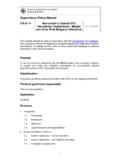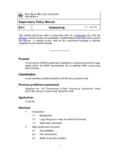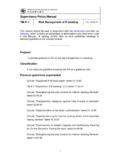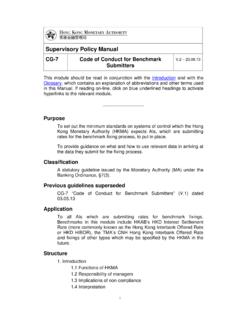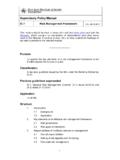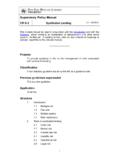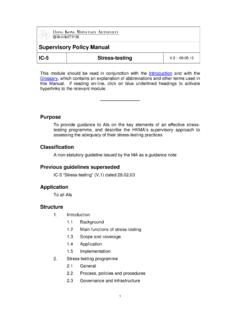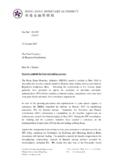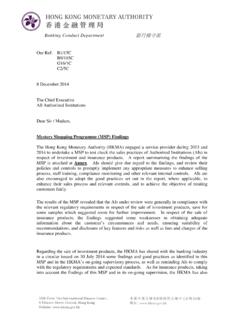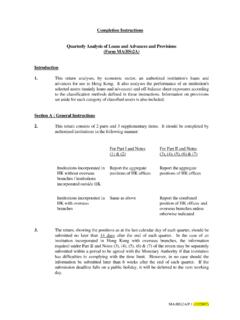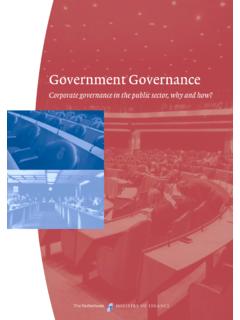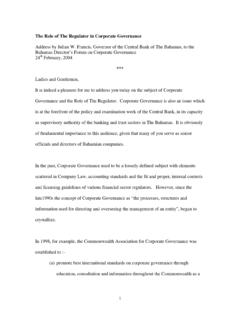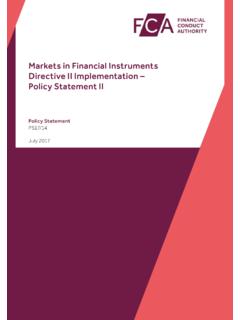Transcription of CG-1 Corporate Governance of Locally Incorporated ...
1 supervisory Policy Manual CG-1 Corporate Governance of Locally Incorporated Authorized Institutions 1 This module should be read in conjunction with the Introduction and with the Glossary, which contains an explanation of abbreviations and other terms used in this Manual. If reading on-line, click on blue underlined headings to activate hyperlinks to the relevant module. Purpose To set out the minimum standards which the HKMA expects Locally Incorporated AIs to adopt in respect of their Corporate Governance . Classification A statutory guideline issued by the MA under the Banking Ordinance, 7(3). Previous guidelines superseded Guideline "Appointment of Alternate directors" dated ; Guideline on " Corporate Governance of Locally Incorporated Authorized Institutions" dated , dated and dated Application To all Locally Incorporated AIs. Structure 1. Introduction Background Application Implementation 2.
2 Responsibilities of the board General Responsibilities supervisory Policy Manual CG-1 Corporate Governance of Locally Incorporated Authorized Institutions 2 Setting and overseeing objectives and strategies Risk Governance Appointment and oversight of senior management Setting Corporate values and standards Remuneration Suitable and transparent Corporate structure Internal and external audit Transparency for sound and effective Governance 3. Organisation and functioning of the board Charter Meetings 4. Board structure Role of the chair Board composition 5. Specialized committees Objectives and practices Nomination committee Audit committee Risk committee Remuneration committee 6. Appointment of directors Fit and proper Commitment Succession 7. Board qualification and training 8. Board performance evaluation supervisory Policy Manual CG-1 Corporate Governance of Locally Incorporated Authorized Institutions 3 9.
3 Governance in group structures AI as a parent or holding company AI as a regulated subsidiary 10. Controls on structures established on behalf of customers 11. supervisory processes for evaluation of Governance supervisory review process Communication with the board and senior management Fit and proper test supervisory Policy Manual CG-1 Corporate Governance of Locally Incorporated Authorized Institutions 4 1. Introduction Background Corporate Governance , as far as the banking industry is concerned, signifies the manner in which the business and affairs of individual AIs are directed and managed by their board of directors and senior management. It also provides the structure through which the strategic objectives of an AI are set, the business plan for attaining those objectives is determined and the performance of the AI is monitored. Given the important financial intermediation role of banks within the economy and the consequences of bank failures to depositors as well as to the financial system and markets in which they operate, effective Corporate Governance within banks is of crucial importance not only to individual banking institutions but also to the financial system and the economy as a whole.
4 The increasingly complex business environment resulting from globalisation, innovation in financial products and technological advances has intensified risk in the banking sector. Against this background, effective Corporate Governance is critically important to ensure that the business of AIs continues to be managed in a controlled, prudent manner. Application This module sets out the HKMA s supervisory expectations in respect of the Corporate Governance policies and practices of Locally Incorporated AIs. It covers the roles and responsibilities of the board of directors ( the board ) of an AI and its senior management, and sets out a range of sound Governance principles and practices. Some key components of effective Corporate Governance frameworks are also contained in other relevant modules of the supervisory Policy Manual, including: supervisory Policy Manual CG-1 Corporate Governance of Locally Incorporated Authorized Institutions 5 Systems of Control for the Appointment of Managers (CG-2) Code of Conduct (CG-3) Establishment of Overseas Banking Subsidiaries.
5 51A (CG-4) Guideline on a Sound Remuneration System (CG-5) Competence and Ethical Behaviour (CG-6) Risk Management Framework (IC-1) Internal Audit Function (IC-2) Reporting Requirements Relating to Authorized Institutions External Auditors under the Banking Ordinance (IC-3) Exposures to Connected Parties (CR-G-9) Reputation Risk Management (RR-1) Strategic Risk Management (SR-1) This module should therefore be read in conjunction with those listed above, as well as any applicable guidance issued and updated by the HKMA from time to time. All AIs are expected to maintain a level of Corporate Governance reflective of the standards set out in this module (and those listed above) in a manner commensurate with the nature, scale and complexity of their operations. Moreover, AIs designated by the MA under 3S or 3U of the Banking (Capital) Rules as global systemically important AIs ( G-SIBs ) or domestic systemically important AIs ( D-SIBs ) are expected to have Corporate Governance structures that are commensurate with their potential impact on financial stability in Hong Kong, and in the case of G-SIBs, globally.
6 Failure to adhere to the standards set out in this module may call into question whether an AI continues to satisfy the minimum criteria for authorization in the Banking Ordinance supervisory Policy Manual CG-1 Corporate Governance of Locally Incorporated Authorized Institutions 6 and may cast doubt on the fitness and propriety of individual directors and shareholder controllers of the AI. Nevertheless, in cases where the standards set out in this module are not met, it may be acceptable for the AI concerned to demonstrate to the reasonable satisfaction of the HKMA that the AI has in place alternative measures which have the equivalent effect of ensuring sound Corporate Governance . In other words, the HKMA will adopt a principles-based approach to assessing the adequacy of the AI s Corporate Governance arrangements and AIs should notify the HKMA promptly of, and provide justifications to support, their adoption of measures which they consider equivalent to those set out in this module.
7 Implementation AIs are generally expected to implement this revised module starting from 1 January 2018. 2. Responsibilities of the board General The board of an AI has the ultimate responsibility for the operations and financial soundness of the AI. In discharging its responsibilities, the board should be actively engaged in the affairs of the AI and cognizant of material changes in the AI s business and the external environment in which the AI operates. Decisions of the board should be taken in a timely manner, having regard to the legitimate interests of shareholders, depositors and other relevant stakeholders. Individual members of the board should act bona fide in the interest of the AI, and on an informed and prudent basis, in accordance with applicable laws, regulations and supervisory standards. Responsibilities supervisory Policy Manual CG-1 Corporate Governance of Locally Incorporated Authorized Institutions 7 The key responsibilities of the board of an AI include: (i) setting and overseeing the objectives of the AI and the strategies for achieving those objectives (see subsection ); (ii) establishing and overseeing risk Governance (see subsection ); (iii) appointment and oversight of senior management (subsection ); (iv) setting Corporate values and standards (see subsection ); (v) overseeing the remuneration policy (see subsection ); (vi) ensuring a suitable and transparent Corporate structure (see subsection ); (vii) ensuring effective audit functions (see subsection ); and (viii) ensuring an appropriate degree of transparency in respect of the structure, operation and risk management of the institution (see subsection ).
8 In establishing an AI s organisational structure, the board should clearly define in a written document the key responsibilities and authorities of the board, senior management and internal control functions in general. The board should also clearly define appropriate internal Governance practices and procedures for the conduct of its own work and have in place the means to ensure that such practices are followed and periodically reviewed. The board should establish and maintain a robust finance function responsible for accounting and financial data to ensure that the AI s business performance is accurately captured and reported to the board, senior management and business lines. supervisory Policy Manual CG-1 Corporate Governance of Locally Incorporated Authorized Institutions 8 Setting and overseeing objectives and strategies The board should set and oversee1 the objectives and overall strategy of an AI within the applicable legal and regulatory framework, taking account of the institution s long-term financial interests, its financial and human resources, its exposures to risk, and its ability to manage risk effectively.
9 The board should also approve business plans for achieving the AI s objectives and ensure that performance against plans is regularly reviewed, with prompt corrective action taken as needed. Among other things, the board should set out its strategic plan for an AI and oversee the AI s capital adequacy assessment process, its capital and liquidity planning and the management of the institution (including compliance policies and internal control systems) so as to ensure that there is adequate capital and sufficient liquidity to cover the risk exposures and liquidity needs of the institution. The annual budgeting exercise is an integral part of the short-term planning and performance monitoring process. The board should approve annual budgets and review performance against these budgets. Risk Governance Risk-taking is an integral part of banking business. The board should have a sound understanding of an AI s business activities and their associated risks, and ensure that these risks are properly managed.
10 To ensure sound risk management, the AI should have an effective risk management framework containing a set of robust risk Governance arrangements and an effective risk appetite framework (see IC-1). In particular, the AI should have an independent risk management function, under the direction 1 In the context of board responsibilities, the term oversee should be understood to mean oversee and be satisfied with . supervisory Policy Manual CG-1 Corporate Governance of Locally Incorporated Authorized Institutions 9 of a Chief Risk Officer2, to oversee risk-taking activities. Procedures should also be in place to outline the actions to be taken by management when risk limits are breached, including escalation procedures and board notification, and disciplinary actions for excessive risk-taking by individual In fulfilling its responsibility to ensure sound risk management as described above, the board should: set an AI s risk appetite framework and ensure that it is consistent with the AI s strategy, business, capital and financial plans, as well as risk-taking capacity and remuneration systems ; approve the AI s risk appetite statement and oversee the AI s adherence to the risk appetite statement; oversee the development and implementation of risk management policies and procedures to ensure that the AI s risks can be identified, monitored and controlled, and that the financial and management information is reliable, timely and complete.
